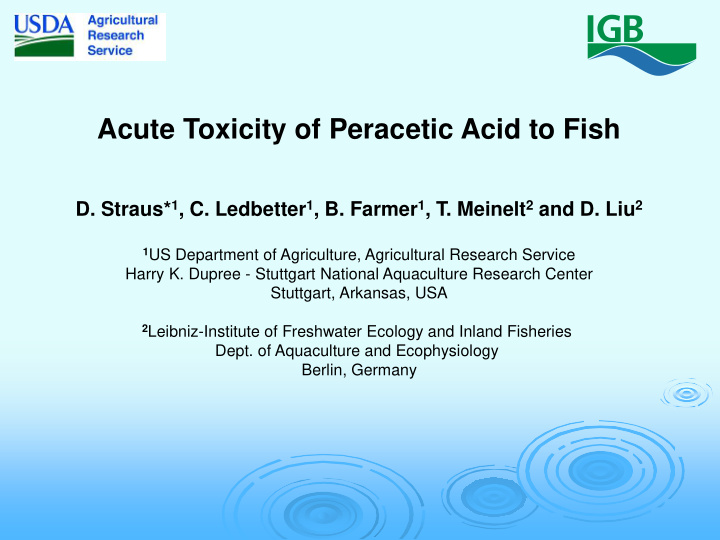



Acute Toxicity of Peracetic Acid to Fish D. Straus* 1 , C. Ledbetter 1 , B. Farmer 1 , T. Meinelt 2 and D. Liu 2 1 US Department of Agriculture, Agricultural Research Service Harry K. Dupree - Stuttgart National Aquaculture Research Center Stuttgart, Arkansas, USA 2 Leibniz-Institute of Freshwater Ecology and Inland Fisheries Dept. of Aquaculture and Ecophysiology Berlin, Germany
Introduction • Peracetic acid (PAA or peroxyacetic acid) is an antimicrobial disinfectant. • Originally registered by the U.S. Environmental Protection Agency (1985) for indoor use on hard surfaces – mainly hospitals. • EPA registrations now include: sanitation in food/beverage plants, agricultural facilities, wineries/breweries, greenhouse equipment, and animal housing. • Also used to prevent bio-film formation in paper/pulp industries and as a disinfectant for wastewater treatment. • This is a promising disinfectant in the US aquaculture industry to control parasites and fungus.
Introduction • In Europe, PAA is approved for use in veterinary medicine and is one of the very few compounds approved for use in aquaculture as a disinfectant. • It is the peroxide of acetic acid and is commercially available in an equilibrium mixture with acetic acid, hydrogen peroxide and water. • It does not leave dangerous residues in the environment when it breaks down like most compounds. • So, it is very environmentally friendly! • However, there is a lack of data on its toxicity to fish.
Introduction • Started collaborations on PAA in 2007 with a colleague in Berlin. • There wasn’t much information on the use of PAA in aquaculture, both in the U.S. and Europe, so we devised a plan to develop research on this subject. • Along the way we have developed relationships with many other collaborators. • Because of our research, we now have a company that is seeking an EPA registration for use of PAA in aquaculture.
Our collaboration is important because of the expertise of each scientist and the limitations on fish experiments in Germany • Toxicity and effectiveness studies at SNARC: • LC50 studies in relevant aquaculture species • Effectiveness studies for aquatic pathogens • In vitro studies in Berlin: • Fungus/bacteria inhibition experiments • Experiments with parasites • RAS (Recirculating aquaculture systems) • Stress and immune response • Degradation of PAA
Previous Research • Toxicity of to Ichthyophthirius multifiliis theronts. • Effectiveness of products to Ich tomonts/theronts. • Effectiveness to control fungus on catfish eggs. • Acute toxicity and histopathology of catfish fry. • Degradation affects of salinity, DOC, and hardness. • Toxicity of products to Daphnia. • Inhibition of Aeromonas and Yersinia . • Toxicity to zebrafish embryos. • Reduction of growth – Columnaris and Saprolegnia.
Current Research • There was not much public data available on the toxicity of PAA to fish. • We set out to determine toxicity and find safe levels for 12 species of fish important to aquaculture.
Materials & Methods • Fish were between 5-10 cm and 2-8 g. • 24 h acute toxicity tests for each species. • LC50 values were calculated using the Trimmed Spearman- Karber method.
Materials & Methods • Ten fish were placed in static 18 L aquaria containing 10 L of well water @ 23°C. • Each experiment consisted of 6 PAA concentrations and an untreated control (n=3). • Water chemistry of the well water was: pH = 7.5, total alkalinity = 200 mg/L, total hardness = 125 mg/L.
Results LC50 values, Lowest Observed Effect Concentration, and No Observed Effect Concentration in the study on toxicity of Peracetic Acid to fish. Latin Name Common Name LC50 Value (mg/L) LOEC NOEC Pimephales promelas Black Fathead Minnow 2.77 2.3 1.9 Notemigonus crysoleucas Golden Shiner 4.07 3.3 2.8 Oncorhynchus mykiss Rainbow Trout 4.17 3.3 2.8 Ctenopharyngodon idella Grass Carp 4.25 4.0 3.3 Carassius auratus Goldfish 4.49 4.0 3.3 Lepomis macrochirus Blue Gill 4.84 3.3 2.8 Ictalurus punctatus Channel Catfish 5.64 4.8 4.0 Micropterus salmoides Large Mouth Bass 5.83 4.8 4.0 Pomoxis nigromaculatus Black Nose Crappie 5.94 5.8 4.8 Sander vitreus Walleye 5.97 4.8 4.0 M. chrysops x M. saxatilis Hybrid Striped Bass 6.17 4.8 4.0 Oreochromis aureus Blue Tilapia 9.31 6.9 5.8 Ictalurus punctatus Channel Catfish a 4.8 4.0 3.3 Ictalurus punctatus Channel Catfish b 5.8 5.8 4.8 a 1/2 Well Water & 1/2 DI Water. b Well Water with 10 mg/L Huminfeed.
Discussion • This is some of the first publically generated data to demonstrate the toxicity of PAA to fish. • Previous data was proprietary. • Black fathead minnows and blue tilapia were most and least sensitive, respectively. • The impact of this research will be to understand the toxicity variance among species and ultimately determine safe and effective treatment rates.
Some favorite photos
Questions? Gerald “Jerry” Michael Ludwig 1944 - 2015
Recommend
More recommend